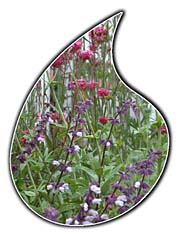|
May 27, 2004
Water-wise gardeningby AMY STEWART
I JUST RETURNED from Washington, D.C., where it is hot in a way that Eureka is never hot. I'm talking about sweltering, steamy, still-warm-late-into-the-night hot. The locals won't see the inside of a sweater for months. And their gardens are packed with summer perennials that wait out the chilly winters and then bloom for months in the glorious warmth. DC gardeners have something else besides heat in their garden, one other thing that I don't have: warm summer rain. I was walking down the sidewalk late Saturday night when someone behind me gasped and said, "I felt a drop! Did you feel a drop?" Her friends all chimed in. "I think I may have. Was that another drop?" Oh, for crying out loud, I thought. Why are these people afraid of a little rain? A few minutes later, I found out. The skies opened and, without warning, rain came down in buckets. There was no drizzle, no fog, no gradual increasing of chill and damp to serve as a warning and allow us time to seek cover. No, suddenly a walk down the sidewalk was just like standing in a warm shower. I was drenched. And I was jealous. Just imagine: free water from the sky in the summer. And no, I'm not talking about these chilly late spring rains we get. I'm talking about warm summer downpours that can happen anytime -- in July, August even. That kind of rain would change everything about the way I garden. As it is, we can go months without a single drop here in the summer, and as a result I've begun to think more and more about ways to conserve water in my own garden. The Mattole Restoration Council is holding a water-efficient gardening workshop in southern Humboldt on June 6 from 11 a.m. to 3 p.m. Gardeners and Mattole Valley residents Joseph and Yani Cook will open their garden to the community and share their experiences creating a water-wise garden. Experts will be on hand to teach about ways to build water-saving garden beds, use small and large-capacity water tanks, and incorporate other water-savvy techniques like permaculture and French-intensive gardening. I talked to Kathy Weber, a Southern Humboldt landscape designer who specializes in water-efficient gardening. She's going to teach a workshop on irrigation; I asked her about some of the most important irrigation issues to consider in a low-water garden. "I see situations quite a bit where people, by whim or whatever, will plant thirsty plants side-by-side with drought-tolerant plants," she said. "I encourage people to move some things around and make some changes so you can water more efficiently. You aren't a slave to your garden." Planting in zones according to water needs, she says, is one way to design a garden that can be irrigated more efficiently. Thirsty plants like vegetables and cutting flowers, for instance, can grow together near the house where there is access to water, and drought-tolerant plants can extend out away from the house where there is less need for irrigation. Weber has developed some interesting techniques that she'll share at the workshop for converting a standard irrigation system to a more water-wise drip system by replacing the sprinkler heads without having to redo the entire system. Even the timing of fertilization can play into water consumption; for many plants, she recommends fertilizing only in fall when water, which plants need to access the nutrients in fertilizer, is naturally more abundant. "We'll also lay out some vegetable beds with soaker hoses," she said, "and look at a lot of different materials for that, like soaker line, T-tape, and some small sprayers. A lot of those vegetables with hairy leaves -- squash, cucumber, melon -- really don't like water on the leaves, so drip irrigation has a lot of other benefits by keeping water off the leaves and cutting down on the spread of disease." She'll also make some recommendations for lawns. "I like dwarf fescue in our area," she said. "It's drought-tolerant, slow-growing -- you only have to mow it half as much as other grasses -- and it doesn't take much water. Most lawn mowers can be adjusted so the blade is four inches high, and if you mow at that higher level, you will save water. There will be less sun beating down on the soil and drying out the grass." All this and more will be covered at the workshop. To get there, head to Thorn Junction (at the junction of Briceland and Whitethorn Roads) just north of Whitethorn, and look for the giant silver water tank and A-frame house on Briceland Road right at Thorn Junction. Bring a picnic lunch, and if you have questions, call Amanda at the Mattole Restoration Council at 629-3514. And if you can't make it to the workshop, check out the High Country Gardens catalog (www.highcountrygardens.com or 800-925-9387) for beautiful garden design ideas using drought-tolerant plants. Although they are located in Santa Fe, many of the plants they recommend do well here. They sell complete pre-planned gardens using Southwestern or Mediterranean plants, but their designs are so lush and lovely that I often lack the patience to order plants from them through the mail. Fortunately, many of their specialties -- penstemon, agastache, salvia, artemesia, and ornamental grasses -- are also available at nurseries around town, where you're sure to find the cultivars that are best suited to our wet winters and dry, thirsty summers. garden-related announcements and news to Amy Stewart. IN THE NEWS | COVER STORY | ARTBEAT | THE HUM | CALENDAR © Copyright 2004, North Coast Journal, Inc. |


